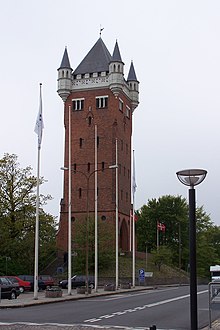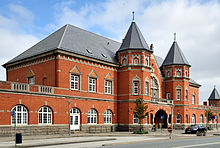Esbjerg
| Esbjerg | ||||
|
||||
| Basic data | ||||
|---|---|---|---|---|
| State : |
|
|||
| Region : | Syddanmark | |||
|
Municipality (since 2007) : |
Esbjerg | |||
| Coordinates : | 55 ° 28 ' N , 8 ° 27' E | |||
| Founded: | 1868 | |||
|
Population : (2020) |
72,037 | |||
| Postal code : | 6700-6715 | |||
| Sister cities : |
|
|||
| Website: | www.esbjerg.dk | |||
 The water tower in Esbjerg |
||||
Esbjerg [ ˈɛsbjɛʀʔ ] ( German Esberg ) is the seventh largest city in Denmark with 72,037 (as of January 1, 2020) inhabitants . The city is located in southwest Jutland . Esbjerg is the only economically important port city on the Danish North Sea coast .
In front of the city is the island of Fanø and to the northwest the Skallingen peninsula , which until April 2008 was one of the few areas in Denmark not yet cleared of landmines .
history
After the entire Danish state had lost the duchies of Schleswig and Holstein in the German-Danish War in 1864 , the kingdom no longer had an efficient North Sea port. Therefore, in 1869, the government decided to build a port in Esbjerg, which also received a railway connection. The construction of this new fortified harbor caused fishing and seafaring from the surrounding areas to move to Esbjerg and the place experienced a rapid boom. The port had to be expanded several times.
The city was dominated by fishing until recently , but the industry has seen a decline in recent years. The Esbjerg Fisheries and Maritime Museum commemorates this chapter in Danish history . Today the offshore sector plays a major role in the city's economy. In addition, cooling elements are produced (Vestfrost).
As part of the municipal reform of 1970, the municipality of Guldager was incorporated with the districts of Sædding, Hjerting and Sønderis.
On August 26, 1981, a Bundeswehr fighter aircraft of the type F-104 Starfighter crashed near the site. It was the 200th crash of this type of aircraft.
Due to a further structural reform, the municipalities of Ribe and Bramming merged with Esbjerg on January 1, 2007 to form the new Esbjerg municipality . The total area of this municipality is 742.5 km², on which 115,483 inhabitants live (as of January 1, 2020).
traffic
The city has the country's most important North Sea port and the Esbjerg power station is also located here . At the beginning of the 21st century, the Esbjerg port profited from the growing offshore industry, especially for offshore wind energy . In 2013 wind turbines for a total of 1.6 gigawatts were handled here. The total handling volume in the port of Esbjerg was 4.6 million tons in 2013, 19,823 ship calls were counted. The turnover was EUR 28.9 million, the profit was EUR 10.4 million.
A ferry connects Esbjerg with the island of Fanø ( Nordby ). There used to be connections to Newcastle (Northern England), Tórshavn (until October 2010) and Harwich (until September 2014).
In the northeast of Esbjerg, outside the city area, is Esbjerg Lufthavn with daily flights to Aberdeen and Stavanger . Supply helicopters take off to drilling platforms in the North Sea.
The railway offers regional connections to Niebüll every two hours, where there is a connection to the trains of the Marschbahn between Westerland and Hamburg .
education
Two universities have a campus in Esbjerg : the University of Southern Denmark (SDU) and the Ålborg Universitetscenter . You can study business administration, tourism, health, sociology and environmental planning at the University of Aalborg, and engineering at the SDU.
Esbjerg also has a well-known music conservatory and music house.
Landmark
The Esbjerg water tower , built in 1897, has become a symbol of the city. The Nassau House in Nuremberg served as a model . The water tower houses a permanent exhibition about the Esbjerg water tower and European water towers, as well as other temporary exhibitions. Another landmark of the city is the monument “ Man by the Sea ”, created in 1994/95 by the artist Svend Wiig Hansen , which welcomes travelers at sea.
media
Esbjerg is the main editorial office of the Danish newspaper JydskeVestkysten , which is a regional newspaper and covers southern and western Jutland including northern Schleswig .
Sports
The football club Esbjerg fB plays in the first Danish league Superliga . In the 1960s it was the most successful club in Denmark, winning the championship in 1961, 1962, 1963, 1965 and 1979 . The ice hockey club Esbjerg IK is another successful sports club. In addition, the Vesterhavs Cup, an international handball and football tournament, takes place in Esbjerg every year . In 2009 the former Esbjerg Stadium was provided with covered grandstands and reopened as the Blue Water Arena with a capacity of 18,000 seats. Motorcycle dirt track races and speedway races take place on the 800-meter-long Korskro Banen dirt track . 1982 and 1985 World Long Track World Championship finals in Korskro near Esbjerg.
sons and daughters of the town
- Henry Dunker (1870–1962), entrepreneur and philanthropist
- Palle Kjærulff-Schmidt (1931–2018), film director
- Per Højholt (1928–2004), writer
- Jens Petersen (1941–2012), football player
- Poul Nyrup Rasmussen (* 1943), politician
- Lars Ulrik Mortensen (* 1955), harpsichordist and conductor
- Erik Gundersen (* 1959), speedway driver
- Ulla Tørnæs (* 1962), politician
- Michael Schjønberg (* 1967), football player
- Henrik Gunde Pedersen (* 1969), jazz pianist
- Jacob Hansen (* 1970), singer, guitarist and music producer
- Peter Skov-Jensen (* 1971), football player
- Camilla Nielsen (* 1972), painter
- Søren Haagen Andreasen (* 1974), handball goalkeeper and handball coach
- Sonja Richter (* 1974), actress
- Niels Kristian Iversen (* 1982), speedway driver
- Tim Winkler (* 1986), handball player
- Kevin Conboy (born 1987), soccer player
- Mikkel Vendelbo (* 1987), football player
- Philip Larsen (* 1989), ice hockey player
- Lotte Grigel (* 1991), handball player
- Louise Burgaard (* 1992), handball player
- Anders Krogsgaard (* 1996), ice hockey player
- Niklas Andersen (* 1997), ice hockey player
Population (municipality)
|
|
|
photos
Catholic St. Nikolai Church (1968/69)
“ Man by the Sea ”, Sædding Strand
Trivia
Esbjerg and the island of Fano during the Second World War served as a motive for the places Morlunde and sands in the novel Midnight Hawks by Ken Follett .
See also
literature
- Esbjergs history. 3 volumes. Esbjerg.
Web links
- City website. Retrieved October 1, 2009 (Danish).
- Esbjerg Tourist Office website. Retrieved April 17, 2010 (Danish).
Individual evidence
- ↑ a b c Statistics Banks -> Befolkning og valg -> BY1: Folketal January 1st efter byområde, alder og køn (Danish)
- ↑ Esbjerg Fisheries Museum. Archived from the original on August 22, 2011 ; Retrieved March 11, 2011 .
- ↑ Michael Meyer: Esbjerg benefits from wind industry · Danish North Sea port increases profit by 28 percent . In: Daily port report of April 3, 2014, p. 13
- ^ Campus Esbjerg of the SDU
- ↑ Man by the sea. (No longer available online.) Formerly in the original ; Retrieved October 1, 2009 . ( Page no longer available , search in web archives ) Info: The link was automatically marked as defective. Please check the link according to the instructions and then remove this notice.
- ^ Vesterhavs Cup. Euro Sporting, archived from the original on August 22, 2011 ; accessed on March 13, 2016 .
- ↑ Book Reporter - Ken Follett, 2002










